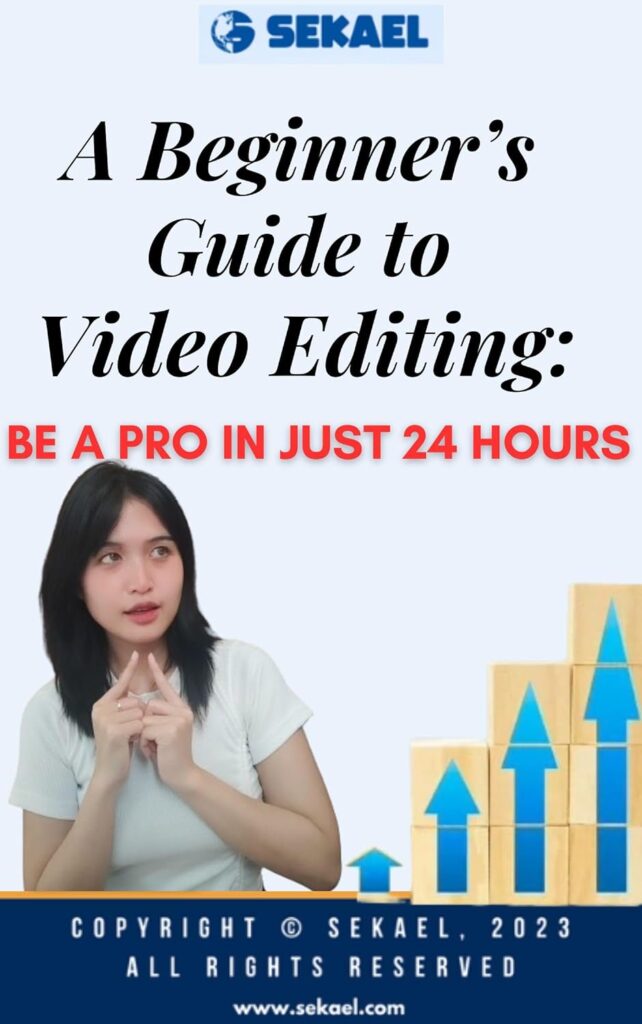
Video Editing Blogs
"Let's Learn, Explore, and Connect to the World"
Diving Into Video Editing: A Beginner's Guide
- Tokita Akira

Introduction
 Video editing, once a skill reserved for professionals with high-end equipment, has become increasingly accessible to anyone with a passion for storytelling and a computer. In this digital age, the ability to edit videos has transformed from a niche technical skill to a versatile tool in everyone’s creative arsenal. Whether you’re aspiring to be a filmmaker, looking to enhance your social media presence, or simply wanting to preserve memories in a more engaging format, learning video editing opens up a world of possibilities.
Video editing, once a skill reserved for professionals with high-end equipment, has become increasingly accessible to anyone with a passion for storytelling and a computer. In this digital age, the ability to edit videos has transformed from a niche technical skill to a versatile tool in everyone’s creative arsenal. Whether you’re aspiring to be a filmmaker, looking to enhance your social media presence, or simply wanting to preserve memories in a more engaging format, learning video editing opens up a world of possibilities.
 As we dive into this beginner’s guide, remember that everyone starts somewhere. With the advent of free, user-friendly video editing tools, you no longer need expensive software to begin your journey into the art of video editing. This guide aims to demystify the process, introduce you to basic techniques, and help you take your first steps in creating compelling video content.
As we dive into this beginner’s guide, remember that everyone starts somewhere. With the advent of free, user-friendly video editing tools, you no longer need expensive software to begin your journey into the art of video editing. This guide aims to demystify the process, introduce you to basic techniques, and help you take your first steps in creating compelling video content.
Why Should We Learn Video Editing?

In today’s fast-paced digital world, video content reigns supreme. Learning video editing isn’t just about acquiring a new hobby; it’s about unlocking a powerful form of communication and creative expression. Here are some compelling reasons why delving into video editing can be both rewarding and beneficial:
- Enhanced Storytelling Abilities: Video editing is much more than cutting and splicing footage. It’s a form of storytelling that allows you to weave narratives, evoke emotions, and convey messages in ways that words or still images alone cannot achieve.
- Career Opportunities: With the rise of digital media, video editing skills are in high demand. From marketing and journalism to film and content creation, these skills open doors to a variety of career paths.
- Digital Literacy: In our increasingly digital world, being fluent in video editing enhances your digital literacy, a skill that is becoming as fundamental as knowing how to use a computer.
- Creative Outlet: Video editing is an art. It allows for creative expression, giving you a platform to share your unique perspective and ideas.
- Community and Collaboration: The world of video editing is collaborative and community-driven. By learning this skill, you join a community of creators, offering opportunities to collaborate, share ideas, and grow.
Whether you aim to pursue a career in video production, enhance your professional skill set, or simply want to create better content for your personal projects, video editing is a valuable skill to master.
Understanding the Basics of Video Editing

Before you dive into the practical side of video editing, it’s essential to grasp some fundamental concepts. These basics form the foundation upon which all your editing skills will be built:
- The Timeline: This is where the magic happens. A timeline in video editing software is the workspace where you assemble your video. It’s a sequential representation of your footage, allowing you to trim clips, arrange them in order, and layer multiple elements like sound and effects.
- Cuts and Transitions: The most basic yet powerful tool in your arsenal is the cut. It’s simply where one clip ends, and another begins. Transitions, on the other hand, are how you move between clips. While there are many creative transitions, a well-timed cut is often more effective.
- Layers and Tracks: Think of your video as a stack of layers. Each track or layer can hold different types of media – video, audio, images, and text. Learning how to effectively manage layers is key to a well-organized and efficient editing process.
- Basic Effects: Even simple effects like adjusting brightness and contrast or applying a color grade can significantly enhance your video’s look and feel.
- Sound Editing: Often overlooked by beginners, sound is a critical component of video editing. The right sound effects, background music, and even silence can greatly impact your video’s emotional tone.
- Exporting Your Video: Understanding video formats and settings is crucial for the final step of the editing process – exporting your video. This ensures your work is compatible with various platforms and devices.
Remember, the goal of editing is not just about putting clips together but telling a story that engages your audience. As you start experimenting with these basic elements, your unique style and storytelling techniques will begin to emerge.
Choosing the Right Software

One of the first decisions you’ll make as a budding video editor is selecting the right software. Thankfully, there are several free options that are both powerful and beginner-friendly. Here’s a look at some popular choices:
- DaVinci Resolve: Known for its advanced color grading and audio post-production features, DaVinci Resolve offers a comprehensive suite of tools. It’s a bit more complex but highly rewarding for those who invest the time to learn it.
- Shotcut: Shotcut is an excellent option for beginners due to its intuitive interface and simplicity. Despite being easy to use, it offers a range of features sufficient for creating professional-quality videos.
- HitFilm Express: This is a great choice if you’re interested in special effects along with traditional editing. HitFilm Express offers a unique blend of video editing and visual effects tools, making it ideal for creating dynamic content.
- Lightworks: With a history in professional film editing, Lightworks offers a robust set of features in its free version. It’s known for its powerful editing tools and ability to handle complex projects.
- iMovie: Exclusively for Mac users, iMovie is a great starting point for beginners. Its user-friendly interface and basic tools make it ideal for quick edits and simple projects.
Each of these programs has its strengths, and the best way to find which works for you is to try them out. Most offer tutorial videos or guides to help beginners get started. Remember, the tool is less important than your creativity and storytelling skills. The right software should feel intuitive and assist you in bringing your vision to life.
Basic Techniques to Get You Started

As you embark on your video editing journey, mastering a few basic techniques can significantly enhance your projects. Here are some fundamental skills that every beginner should know:
- Trimming and Cutting: The core of editing is deciding what to keep and what to remove. Learn how to trim the start and end of your clips to focus on the most important parts. Cutting is about removing unwanted sections from the middle of your clips.
- Sequencing: This involves arranging your clips in a logical and aesthetically pleasing order. Think about the story you want to tell and how each clip contributes to it.
- Adding Transitions: While a simple cut is often best, transitions can add style and smoothness to your video. Experiment with different transitions but use them sparingly to avoid a cluttered feel.
- Basic Color Correction: Adjusting the color of your footage can dramatically change its mood and consistency. Learn to balance colors for a more professional look.
- Adding Text and Titles: Text and titles can provide context or enhance your story. Discover how to add simple text overlays, and try different fonts and animations to see what fits your style.
- Working with Audio: Learn the basics of audio editing – how to adjust volume levels, add music, and use sound effects. Good audio is crucial for an effective video.
- Exporting Your Project: Understanding the right format and settings for exporting your video is essential. Learn about different file formats and which is best for your intended platform (YouTube, Instagram, etc.).
These techniques are your first steps into a larger world of video editing. As you practice, you’ll develop your unique style and discover more advanced techniques to explore.
Tips for Improving Your Editing Skills

As you get more comfortable with the basics of video editing, it’s important to continue developing your skills. Here are some tips to help you improve and refine your video editing abilities:
- Practice Regularly: The best way to improve is by doing. Set aside regular time to practice editing, experiment with different techniques, and work on various types of projects.
- Analyze Professional Work: Study videos from professionals. Pay attention to their editing styles, how they cut scenes, use transitions, and handle audio. Try to implement some of these techniques in your own work.
- Seek Feedback: Don’t be afraid to ask for feedback on your videos. Constructive criticism from friends, family, or online communities can provide valuable insights and help you grow.
- Learn from Tutorials: There are countless online tutorials for every video editing software. These can be incredibly helpful for learning new tricks and understanding advanced features.
- Stay Updated: Video editing software and techniques are always evolving. Stay informed about the latest updates and trends in video editing.
- Experiment with Different Styles: Don’t limit yourself to one style or type of video. Experimenting with different genres and techniques can help you discover your unique editing style.
- Backup Your Work: Always keep backups of your projects. Losing your work can be discouraging, so make sure to save frequently and keep copies in different locations.
- Mind the Story: Always remember that your main job as an editor is to tell a story. Every cut, transition, and effect should serve the narrative you’re trying to convey.
By following these tips and continually challenging yourself, your skills as a video editor will steadily improve. Remember, every expert was once a beginner, and the key to success is persistence and passion.
Conclusion

As we reach the end of this beginner’s guide to video editing, remember that your journey is just beginning. Video editing is not only about mastering software or techniques; it’s about discovering your voice and telling stories in your unique way. The satisfaction of creating something that resonates with others is unparalleled, and every video you edit brings you one step closer to this achievement.
Remember, every skilled video editor started where you are now. With patience, practice, and persistence, you too can transform your creative visions into captivating videos. Don’t hesitate to start experimenting, learning, and most importantly, enjoying the process of creating.
We encourage you to take the first step today. Download a video editing software, gather some clips, and start playing around. There’s no better way to learn than by doing, and who knows where this journey might take you?
Happy editing!
Check out our books and more!
A Beginner's Guide to Video Editing: Be a Pro in Just 24 Hours
Discover your inner editing abilities with this complete guide made for beginners to master the art of video editing smoothly. ‘A Beginner’s Guide to Video Editing: Be a Pro in Just 24 Hours’ is your way to discover the secrets of professional-grade editing within a day.
